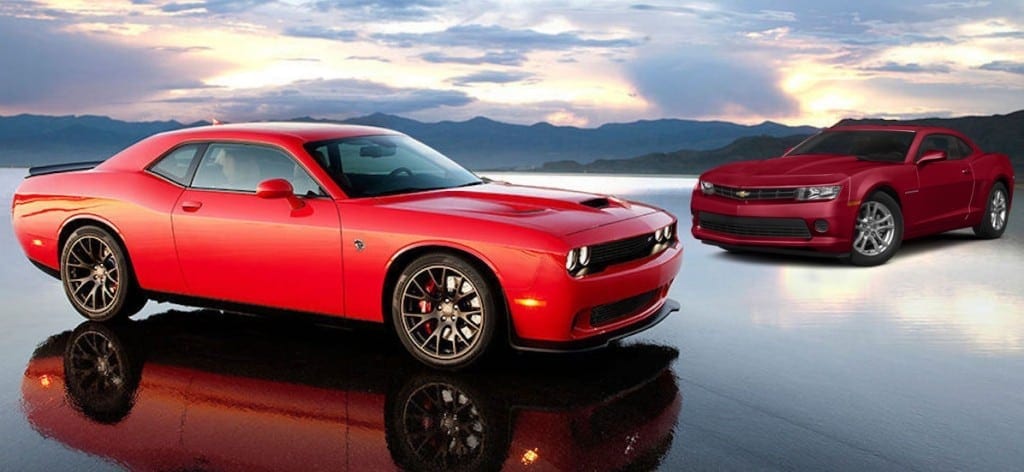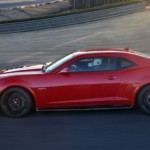This is certainly an interesting time for muscle cars, and vehicles like the 2016 Dodge Challenger for sale right now are performing like we’ve never seen before. As far as the competition of the Challenger goes, we already know it can destroy the Shelby GT350R in a race, but how about the 2015 Camaro Z/28? (Still the strongest Camaro offered by Chevy). Both vehicles are distinguished by a storied history and a legendary status, considering, for example, that the Z/28 was designed back in 1967 specifically for competing in the Sports Car Club of America’s Trans-Am 2 class. While it’s obvious that the Challenger is currently the most powerful muscle car ever produced, the Camaro Z/28 might take advantage of the Challenger’s bigger size and weight.
It’s time to see who would win when these two go at it. Whatever the outcome, one thing is for certain – seeing these two titans throw-down on the track would be a flurry of screeching tires and smoke.
Engines
Both vehicles come with a single engine choice; the 2016 Dodge Challenger houses a supercharged 6.2-liter Hemi Hellcat engine, and the core of the 2015 Camaro Z/28 is a 7.0-liter LS7 engine. The Hellcat engine is more traditional, using supercharging technology to give the car a powerful and modern boost of raw, unrelenting, and unbridled old-school muscle. The LS7, however, took the legendary GM small block design and developed it with lightweight racing-quality components such as titanium intake valves and connecting rods for durability. The dual-mode exhaust system and cold air induction system help maximize the airflow, and a dry-sump oiling system effectively pressurizes oil for enhanced engine protection at stupidly fast speeds. In conclusion, the Camaro Z/28’s engine has newfangled technology on board to aid in performance, and the Challenger’s engine has more of a classic feel to it.
Keeping that in mind, let’s look at some numbers. The 2016 Dodge Challenger’s engine cranks out a legendary (and record-setting) 707 horsepower and 650 lb-ft of torque, while the Camaro’s engine only puts out 505 horsepower and 481 lb-ft of torque – measly in comparison. In terms of muscle and raw power, it’s clear that the Challenger is the winner with over 200 more horsepower and torque than the Camaro’s engine. But, the engine on the Z/28 is much lighter and more advanced. So the question remains, which one benefits their respective vehicle better?
For that answer, let’s take a look at some performance times to see if that raw unbridled muscle is enough to beat the lighter engine/frame on the Z/28.
Performance Times
In Edmunds track testing, the Challenger SRT Hellcat was able to do the 0-60 mph sprint in an unbelievable 4.1 seconds. The Camaro Z/28 comes in a close second, with a 0-60 mph time of 4.5 seconds. Obviously, the raw muscle in the Challenger’s engine dominated the Camaro in a sprint from 0-60 mph, which was almost expected. But, what about on a quarter-mile track? Without modifications to the engine, Torquenews reported a Challenger Hellcat running a quarter-mile time of about 10 seconds, which is crazy fast compared to what it used to be. The Camaro Z/28, according to MotorTrend, lags behind, clocking in at 12.1 seconds without engine modifications.
Even though times have changed, it’s clear that the assumption more muscle equals faster drag times hasn’t. However, racing on a track is much different than racing side-by-side in a straight line, which is where the Camaro’s lighter weight frame and engine, along with its smaller size, will prove advantageous.
Advantages of the Camaro
The Z/28 is both lighter and smaller than the Challenger, with a lighter engine as well. This spells trouble for the Challenger in a few ways; the first is the cornering. Obviously, when you go into a corner you need to slow down a bit. With experienced driving techniques and the proper setup, the time it takes to edge a corner is reduced.
A big component of the right set up is a smaller size vehicle. Inherently, the Challenger is going to have to take a wider turn than the Camaro and while it may have stellar handling for being the largest and heaviest muscle car, the Camaro still needs to take turns easier simply because of how much smaller it is. Also, the helical limited-slip differential that’s equipped on the Z/28 helps enable responsive corner entry by maximizing traction through the turn. That increased amount of traction allows for a slingshot effect when the corner is finally exited, ultimately promoting stronger acceleration after leaving the turn.
However, the lighter body and engine, coupled with the naturally aspirated handling are the only two “advantages” the Camaro has over the Challenger.
Advantages of the Challenger
Dodge knew their Hellcat was the heaviest muscle car on the market, and it might have been cumbersome while taking corners if it wasn’t properly equipped. Enter the SRT-Tuned Three Mode Adaptive Dampening System, which features three modes to maximize performance: Street Mode, Sport Mode, and Track Mode. Track Mode provides maximum handling plus performance shifting and gear holding. It’s an independent front short and long-arm suspension design —which helps keep turning as tight as possible — while the multilink rear design provides incredible control regardless of the driving condition. This performance-tuned suspension with responsive handling is Dodge’s answer to vehicles like the Camaro that have a limited slip differential, giving the Challenger a fighting chance.
Between the insane amount of power, and the above-average handling for a vehicle this size, the Challenger is a fair match against the Camaro. However, the differential and lightweight design of the Z/28 let it run a Nurburgring track time of 7:37, whereas the heavier SRT Hellcat came in at 7:51; both times were reported following tests administered by the automakers themselves.
The Verdict?
While the Camaro is proven faster on the track, the Challenger absolutely stomps on it in a 0-60 mph race and quarter-mile drag bracket, which is what old-school muscle is supposed to do. In my opinion, the victory should still go to the 2016 Dodge Challenger SRT Hellcat. Why? Simply because the Challenger is able to beat the Camaro in 2/3 of the racing categories, and do it with the power and style of classic muscle. The Z/28’s engine is designed more like a modern sports car engine, whereas the Challenger only has the super-charging technology to enhance its iconic muscle that’s persisted throughout the years.
In the end, the Challenger might not be the fastest muscle car, but it’s certainly the most powerful. Plus, it’s able to give the competition a run for its money, while still providing arguably the more traditional hot-rod driving experience.







